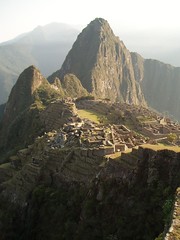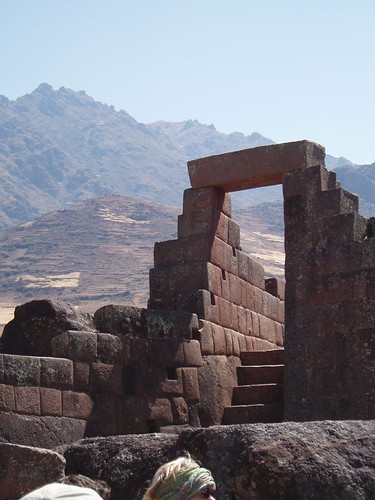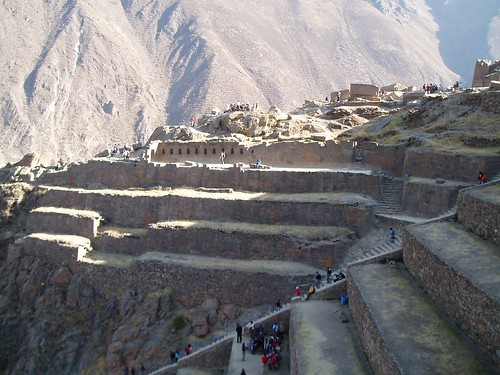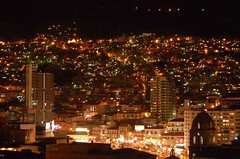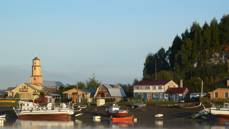Machu Picchu
We rose from our bed at 4:12 AM, three minutes before our alarm clocks were to sound. Neither Jojo or I could sleep any more, and we confirmed with groggy musings that neither of us slept well anyhow, there was just too much excitement. Our outfits for exploration and adventure had been chosen and laid out the night before, as well as our provisions packed and my backpack readied for the day. Within fifteen minutes we were ready and assembled. A few last minute changes and additions and subtractions from our gear and it was time to go.
I told you in my last post about the Peruvian couple we´d met at the train station in Ollantantambu, and my discussion of an alternative, and free, route into Machu Picchu. I´d arranged to meet them at 4:30 AM in the plaza, but both Jojo and I had misgivings about this clandestine entry method, and when we´d gone to sleep decided to wait until the morning came to decide. In fact I had decided to let fate decide. I thought the fates had decided when we left our room 5 minutes late for a prompt meeting time. Well they fates were fooling with me and lo and behold the couple was there waiting. We joined them and began our walk towards the park, down the road from Aguas Calientes, through the train station. The lady from Peru needed to buy her train ticket so we stopped at the station... it was closed. So we ran/walked up to the new station, back the wrong way. We waited. The Fates played cribbage with my patience. Finally she had her ticket and we were off.
We walked down the lit road by the river surging nosily next to us in darkness, towards the entrance and the bus station that takes less inclined, and more monetarily endowed, tourists up to the actual park. We didn´t know how far or how long it would take us to ascend up to Machu Picchu but we were determined not to pay the $6 for a bus. The sky began to lighten as we walked, and shortly after the bus station we no longer needed our flash lights. This increasing light in the valley and the sky above exposed to us for the first time our surroundings. Everyone has seen the pictures of Machu Picchu with jagged and steep clif-side mountains lacerating the misty clouds in the Andean jungle range, but unless you go there you will never really appreciate the drama and intensity of the valleys and peaks of this sacred setting.
The pre-dawn light began to suffuse the air with a subtle glow. The light color of the gravel road showed us our way, and up above us the stars grew dim as the sky lightened. And this lightening exposed the silhouettes of the peaks all around us. Like opening your eyes for the first time from a dream we understood for the first time where we were. In every direction jagged but round, like tusks or the incisors of a sabre tooth tiger, mountains rose. The valley parallel with our road but turning around corners of sheer cliff filled with a frothy and flowing rapid. Our necks began a craning that would last the day.
Eventually we found the bridge that crosses the river, and on the other side the split of road and trail. Our travel partners, already huffing after a walk on a road, and mostly downhill paused to prepare themselves for the ascent. Like we´ve said, traveling from sea level to Machu Picchu is difficult and testing. Traveling to Machu Picchu from La Paz is like going to the beach. A simple sign pointed our way, and from the very first step the trail was stairs.
Stone steps placed into hard clay soil and verdant foliage all around. The steps curled upward in a zig zag, uneven and rough, but steadily and constantly climbing. The pictures of Macchu Picchu floated in my vision - a city atop a ridge nestled between peaks. How high would we have to climb? All of a sudden the claims of one hour and forty five minutes seemed more plausible. But we were not concerned. I had our pack and two liters of water to keep me company, and as a group we began to ascend.
As we climbed higher so did the sun, but still a long way off from visible. The mountains all around shielded us from his rays (The sun is the father in Incan tradition), and the valley and Macchu Picchu would not see direct sunlight for a good time yet.
Which turned out to be a very good thing for our sunrise viewing opportunity. After a very short while we all stopped together to remove our outermost layer, and shed some heat from the climb. Jojo and I were in front by a few steps and quickly stowed our sweaters in the pack (more weight, but the excitement was like a balloon on my back) and were ready to resume climbing the stairway to heaven. Our Peruvian buddies needed a bit more of a break. They were both short of breath and dripping with exertion. We waited with them again, and soon were off again. But this time I noticed a drop in their pace and after ever 50 or so meters gain in altitude they needed to stop for breath.
Well, the fates were meddling again and this time I decided to make the decision for myself, and for my own experience, precious as it was to me. I continued on. Jojo by my side, and more often than not in front of me. We plodded on. Lento, Contento, Left, Right, breathe in, breathe out, lento, contento (slowly, contentedly). My mantra of breath and pace, I plodded up the switchbacks and stairs slowly and evenly, step by step. It is a long way up.
After about fifteen minutes of climbing this way we both knew the Peruvians were a long way back. Jojo didn´t feel right in just continuing on without telling them so she headed BACK DOWN and left me to lento and contento on my own. We had decided, after much consideration and the intervention of the fates that paying entry to such a monument showed the respect we think it deserves. I continued on, climbing the stairs and the sky lightened and the valleys opened up to vistas of intense beauty. The day had begun officially and correctly, and our destination lay ahead and above, our ascent a confirmation of our desires and loyalty to see them through.
Jojo passed me shortly thereafter and continued at a jog up the stairs. She is a marvel of strength and resolution, of beauty and delight. Watching her ascend ahead of me, disappearing into the brush at a trot, the sky coloring to pale pink, i lowered my head and continued my ascent secure in my emotions and excitement that this show of dedication and respect on our part would repay us in a day of incredibly discovery and delight.
____________________________________________________________
Like a wave surging up out of the deep as it approaches the shore, and then crashing with inevitable clamor on the beach I emerged from the trail onto the arrival platform and entrance to Machu Picchu. My head had been bent down as Lento and Contento kept me company and assured me that the view they provided was like the wrapping on a present. When at last I raised my head at the end of the trail my destination greeted me and I was giddy.
There are very few signs in South America, and the biggest and most visited tourist attraction is no exception (how can this be!!! thousands visit this park daily, and yet there is no ENTER or EXIT sign posted, no TICKETS, or Don´t Feed the Pigeons.. nada, just follow the crowd). We followed the crowd, what else could we do. After much uncertainty we confirmed that the line we were now standing in was indeed the ticket line. Our soon to be guide had told me the night before we could buy tickets at the entrance, so we felt a certain sense of relief when that hope was confirmed. Concurrently it was fortunate for us that I saved our last cash on the off chance that the Biggest Tourist Attraction in South America didn´t accept credit cards. Well, almost all of one´s preconceptions are challenged and destroyed in South America and this as well was no exception. We even got in for .50 Soles off because the TICKET OFFICE DOES NOT HAVE CHANGE. I kid you not. This place is crazy.
But. But... But we got our tickets. In hand, whew.
Our ¨guide¨ with whom I´d made arrangements the night before in a personal meeting approached. We were to meet him at 6:45 AM outside the entrance and as he approached I looked him in the face, said ¨Hola¨ and he walked right on past without a trace of recognition. Mystified I watched him enter a bit farther in and begin to call people over to him for ¨Marco´s Group!¨ I had thought (from our meeting the night before) we would be getting a private tour, but apparently I was wrong yet again. Nothing would diminish this day though so we decided to proceed with the tour anyway. Jojo made yet another good call at this moment. It seemed there were two tours, one in Spanish and one in English. She said she´d rater go with the Spanish tour guide. And so we did.
We ascended immediately to one of the highest points in the park and were told to wait there for everyone else. Well, it turns out it wasn´t just to wait for the group but to also wait for this view.
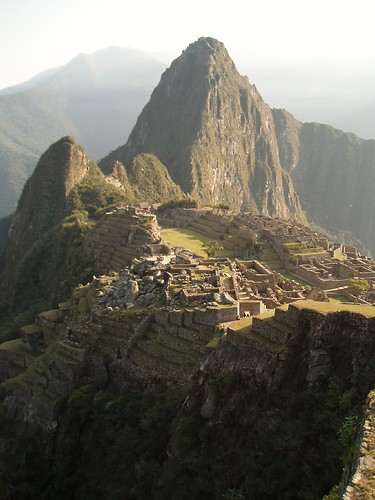
The sun had just crested the mountain across the valley and rays of sunlight were carving lines through the sky, and projecting a glow upon the ruins. This is pretty much the first view of the ruins you see, and it is incredible.
After a few minutes we gathered a bit father back and up on some terraces. I have to diverge for a moment here and explain a little bit about the terraces. The Incas, and pretty much all of the ancient - and some current civilizations, in this area (a very large area) were terrace crazy! They LOVED them. They built them everywhere. Everywhere, i mean it. Look out the window on the train, terraces. Look out the window of your hotel, terraces. It´s steep country here, but even where it isn´t, terraces! Agriculture was goin´ off here for thousands of years, and man, it was a good time for terraces. I guess there was a lot of stone just laying around and to be quarried as well, but I think they would clear the land of stones and just use it to build walls for terraces. They got all funky and technological with them too, using gravity fed watering systems and micro climatology to grow different crops on different terraces. These people were smart, creative, hard working, and worked together on everything. Too bad they were mostly killed off by bastard conquistadors, no?
Anyhow we were told to wait here, yet again, and took some more pictures, but being novel adventurers and anarchists of a sort we couldn´t just wait when there was so much to explore. In fact, Jojo spied some llamas (her favorite creature on earth.. I think i come in somewhere in the top ten) and took off to say hi and take pictures. I joined Jojo as it became clear the guide wanted us to sit on the ground around her to wait for the rest of the crew, and upon inspection I discovered that the ground was wet.
We returned shortly thereafter to begin the tour. It was educational and informative. If a bit authoritarian. But I enjoyed learning all that I could about the area and the history of it´s builders. We ascended to a point high up on the terraces on the mountain Machu Picchu, and learned about the construction of the stand alone buildings. The Inca´s use sloping walls, and trapezoidal windows and doorways, all narrowing towards the top. This construction technique has enabled their buildings to stand for hundreds of years in an incredibly active seismic area. Indeed the colonial buildings that have replaced or covered many of the Incan sites (or simply filled in the gaps) have fallen over repeatedly and the Incan buildings show only signs of weathering.
Our tour led around and across the site of Machu Picchu, past working quarries and stone fields to temples, terraces, complex solar calendars, ritualistic sites, and holy shrines. The shrines and calendars held my greatest interest next to the simple and constant awe inspired by the architecture and masonry. The Incas worshipped nature, and their most powerful representation was in a three part dynasty of gods; The Condor, representing the heavens and sky, The Puma, representing the land and realm of humans, and The Serpent, representing the underworld but not in a satanic or dark sense in any way. The Serpent represents wisdom and understanding. In another sense the Incas worshiped nature in general, and any aspect of nature that exhibited difference was respected and in some cases worshiped.
This respect extends to rock formations, geological formations, rivers, people, animals, and probably trees and plants as well. It is a very simple religion, and one of connection and cycles rather than differences (despite the respect for distinction, I can see how this would be confusing, but if you consider the inclusiveness of their worship it makes good sense).
We walked in a large group with the tour and eventually made our way to some very impressive temples with stones of incredible size and workmanship. It is hard to imagine the work and techniques they employed when standing there surrounded by tourists and cameras clicking away. We paused in one temple with three windows, and across from them three rocks of different size. Each window is aligned with a certain rock so that at different times of the year, at sunrise, each window casts a special shaft of light, and upon the rock a special shadow is in turn cast. It is a very delicate and simple method for understanding the year, and from all we know, empirically successful. The Incas were incredible agriculturalists and fed a large population equitably and successfully for many generations.
Next we came to a special rock with many strange protuberances and projections that was used at noon but for the same purpose as the windows described above. The most sacred temples at Machu Picchu were dedicated to these (mundane? only to us, with our modern systems that we rely on to a fault) systems of understand the calendar.
From there we progressed across the fields in the center of the site to the far end at the foot of Wainu Picchu, the tall pointy peak pictured on the far side of the ruins in the photo at the top of this blog. It is an incredible peak with a dangerous and steep trail to the top where there are more ruins and an incredible view. Our guide told us that we could climb it now, or wait until the end of the tour. Being hungry for more information and history we decided to wait. A mistake that will only be repaired at some unknown future return to Peru.
We continued circling back now towards our starting point going past an incredible wall that can only be described as a perfect blend between natural and man made. It is clearly of a different style and age, and predates the Incas. The stones are much more naturally shaped and of more varying size and to look upon this wall is to question all of your assumptions about the works of man.
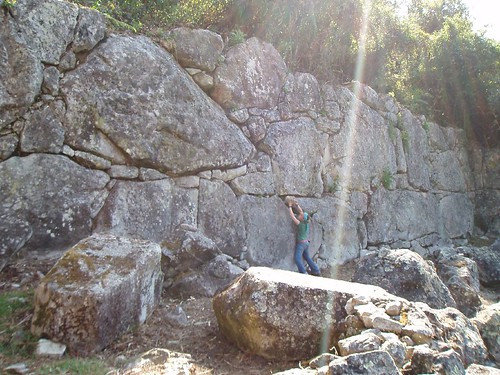
Further on we passed through the main residential section of the site with many separate buildings with tall ends for peaked roofs. All of the wood and straw roofs are gone now, but the forms of the buildings echo their past, and the ghosts of the roofs were all I needed to call up visions of their ancient inhabitants. IN this area is a temple with two very low bowls in the floor made of stone. They look rather like ancient dog dishes, but in fact are water-mirrors used for reflecting the passages and positions of stars. A stone would be placed in the bowl at the position of a star as it rose, and another as it passed from view. In this way the Incas could track the positions of the stars and planets accurately and in a way much easier to understand than pointing to the sky.
Towards the end of our tour we visited the Temple of the Moon, and Temple of the Condor. Both located and built upon large natural boulders that had been carved only slightly, but accentuated in their form and importance. Our guide finished her spiel in a large room and insisted on taking our names down. This took forever and our impatience grew as the sun beat down and the minutes ticked by. Somehow we knew we had to get back to Waynu Picchu. Finally we were released and Jojo and I hurried back to the far end of the site.
We arrived at a line of about 15 people. We were the first from our group to arrive, and we began to wait patiently. Shortly an official came out an announced that we were nearing the daily limit of 400 hikers for the mountain. He proceeded to make a count of the people in line and lo and behold we were numbers 401 and 402. Dismay hit us like an intricately carved boulder, but we waited to see if the count might change. Other eager hikers arrived behind us, and a few, in incredible arrogance and with a rudeness unequaled in all our travels tried to cut in line right in front of us! We were in awe of their behavior but held back from forcibly pulling them out of the way by the simple fact that neither they nor us would likely enter... but... if the count were to change, justice would have been done.
Luckily and unluckily none of use were admitted and we had a good laugh at the expense of those rude cutters with some other hopefuls. So we left the waiting area (truly just a large clearing of rock and earth at the edge of an incredible cliff where the path was gated). Jojo and I decided it was time for a break and found a large boulder to mount and sit for a bit in the sun, basking in the incredible beauty of our surroundings.
The only real way to understand the beauty of this place, or any for that matter, is to go there. And I will add some more pictures to this blog as I can, but for now, just let your imagination go and if you ever get there, you will realize it is far more amazing, and bizarre than you could ever imagine. Jojo and I wandered through the ruins, retracing our earlier path and discovering other nooks and crannies. Mysterious caves, tiny rooms carved directly from living rock, and incredible systems of terraces, hydraulics, and architecture. We walked back across to where we started our tour and down a couple of levels to a terrace where we decided to stop for a while to nap, draw, and snack.
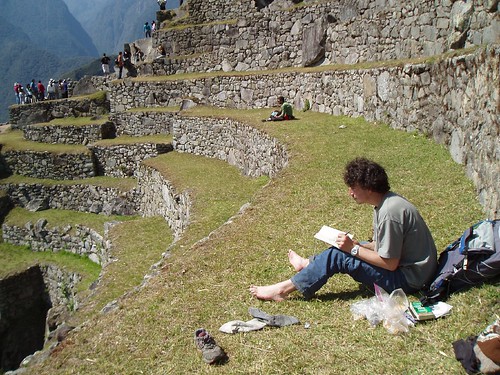
When I had finished my sketch (INCREDIBLY difficult to draw such an intricate and natural place, with such magnitude and majesty) and Jojo had napped sufficiently we gathered our belongings and ourselves and prepared to do an alternative hike to the other end of the site, to Portal Del Sol, up a long and continuously sloping trail traversing the mountain Machu Picchu. There are a couple of ruins along this trail including some gathered below a huge rock jutting up and out from the mountain side, much like Pride Rock in The Lion King. On our way up to Puerto Del Sol we passed by this incredible rock, eager to ascend to this high gate to the next valley.
At the top of the trail is a small ruin, that is a series of gates and perhaps a room or two that sit in a notch between two peaks, and is the entrance point for the Inca Trail to the ruins (or so we believe from the signs we saw). Looking back to Machu Picchu is an incredible open vista of the ruins and site, and the peaks beyond, and the river below. It was with a bit of surprise that we realized we were now higher than Waynu Picchu, the peak visible beyond the ruins! It is amazing the difference between a direct climb and a steady ascent. We sat and pondered this vista and the place we have been blessed to be able to visit.
It was with weary feet, grumbling stomachs, and a full day of delight that we began our descent back to the main part and ruins, and eventually, back to Aguas Calientes. As we descended and came upon the Giant protruding rock I described above a powerful desire, nay need, came upon me to get a bit closer and view the base of the rock and the ruins around. Jojo´s tired feet held her to the trail as I bounded at a run up the gentle steps through the small ruins. Immediately as I cleared the last step and looked up I was blessed with an incredible and sacred vision.
A Condor stood perching on a tree just twenty feet away from me as surprised at seeing me suddenly appear as I was at seeing her. She was an amazing site to behold. Powerful full body and profile, her neck curving down and up to a head the size of a baseball and a beak both powerful and graceful. Her tail feathers stood out in silhouette in a gap in the foliage of the tree. Her dark brown plumage disguised her form in the shadows beyond, but like seeing the sun blazing for the fist time in weeks (Portlanders, you know what I´m talking about here), or the moon rise above a distant horizon bright full and heavy she filled and shocked my vision.
I was in awe and my reactions were unschooled and perhaps uncouth. Instead of stopping and showing my respect I was drawn on, approaching like a child, curiosity dominating my mind. She looked at me, with her predators eyes, neck curving around, took my measure in full, turned and disappeared into the trees behind her, hopping down and out of site. I called ¨Jojo! A Condor! I just saw a Condor!¨ She came running up, but by that time the Condor was long gone.
I don´t wish that I´d behaved differently. I behaved out of instinct and awe, and in some way I know that was the most honest and wonder-filled reaction I could possibly have. Jojo declared immediately and correctly that I had been blessed by the spirits of the mountains and the sky, and I agree with her fully. I cannot think of any other way to have ended my experience at Machu Picchu better or with more reverence and appreciation for this place. As we descended further, through the ruins, out the gate, past the bus station, and down the long stair to the road this thought echoed in my mind and heart. A dream of seeing this most excellent example of human work and connection to nature had finally come to be, and in a way that I could never have imagined or hoped.
Indeed we did have a great day and as the descent stretched into the late afternoon hours we both rejoiced in our experience, culminating in a sweet and well deserved high five at the bottom of the stairs. We walked back up the road we had walked down that same morning, tired and hungry, and reentered the world of tourists. We ate dinner that night at Chez Maggie´s with an incredibly wonderful and welcoming host, and went to bed early, grateful and content. We had an early train the next morning, at 5:45 AM back down the valley to Cusco, and I am sure my dreams were quiet and peaceful.
